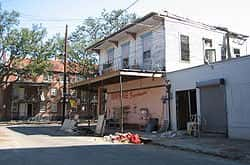Storyville

Storyville was the Red-light district of New Orleans, Louisiana, from 1897 through 1917. Locals usually simply referred to the area as The District.
Contents
History
The nickname Storyville was in reference to city alderman Sidney Story, who wrote the legislation setting up the district. It was bounded by Iberville, Basin, St. Louis, and N. Robertson streets.[1] Most of this former district is now occupied by the Iberville Housing Projects, two blocks inland from the French Quarter.
The District was set up to limit prostitution to one area of town where authorities could monitor and regulate the practice. In the late 1890s, the New Orleans city government studied the legalized red light districts of northern German and Dutch ports and set up Storyville based on such models. Between 1895 and 1915, "blue books" were published in Storyville. These books were guides to prostitution for visitors to the district's services; they included house descriptions, prices, particular services, and the "stock" each house offered. The Storyville blue-books were inscribed with the motto: "Order of the Garter: Honi Soit Qui Mal Y Pense (Shame to Him Who Evil Thinks)."
Establishments in Storyville ranged from cheap "cribs" to more expensive houses, up to a row of elegant mansions along Basin Street for well-heeled customers. New Orleans' cribs were 50-cent joints, whereas the more expensive establishments could cost up to $10. Black and white brothels coexisted in Storyville; but black men were barred from legally purchasing services in either black or white brothels. Brothels with black prostitutes serving blacks openly flourished with the full knowledge of the police and other local authorities a short distance uptown from Storyville proper.
The District was adjacent to one of the main railway stations, where travelers arrived in the city. It became a noted attraction.
Jazz did not originate in Storyville, but it flourished there as in the rest of the city. Many out-of-town visitors first heard this style of music there before the music spread north.[2] Some outsiders continue to associate Storyville with the origins of jazz. It was tradition in the better Storyville establishments to hire a piano player and sometimes small bands.
Closure
The US Army, driven by a reformist attitude at home, prohibited soldiers from frequenting prostitutes, based on public health. In October 1917, shortly after the United States entered World War I, Secretary of War Newton D. Baker said: "These boys are going to France. I want them adequately armed and clothed by their government; but I want them to have an invisible armor to take with them . . . a moral and intellectual armor for their protection overseas."
Aided by the campaigns of the American Social Hygiene Organization, and with army regulations that placed such institutes off limits, he implemented a national program to close so-called "segregated zones" close to Army training camps.
In the early days of the war, four soldiers were killed within the District within weeks of each other. Both the Army and Navy subsequently demanded that Storyville be closed down, with the Secretary of the Navy Josephus Daniels citing the district as a "bad influence".
The New Orleans city government strongly protested against closing the district; New Orleans Mayor Martin Behrman said, "You can make it illegal, but you can't make it unpopular. After 1917, when Storyville was shut down, separate black and white underground houses of prostitution were set up around the city.
The District continued in a more subdued state as an entertainment center through the 1920s, with various dance halls, cabarets and restaurants. Speakeasies, gambling joints and prostitution were also regularly found in the area despite repeated police raids.
Today
Almost all the buildings in the former District were demolished in the 1930s during the Great Depression for construction of public housing, known as the Iberville Projects. While much of the area contained old and decayed buildings, the old mansions along Basin Street, some of the finest structures in the city, were also leveled. The city government wanted to change the area by demolition and new construction. Basin Street was renamed "North Saratoga" (its historic name was restored some 20 years later).
